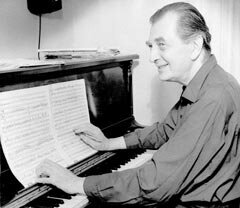
Alexander Tcherepnin at the piano
Alexander Tcherepnin: Symphony No. 2, Op. 77
“To live through the Occupation was not easy,” he remembers, “and I had to compose lots of trash for dancers, for music halls, and so on, which had to be signed by another name because I was Russian.” But once the Occupation was over, “my fertility returned.” And it was within this period of renewed creativity that Tcherepnin set to work on his Second Symphony. However, since he started to resume his traveling and concertizing, the completion of the work took somewhat longer than expected. He toured America in 1948, and together with his wife, accepted a teaching position at DePaul University in Chicago. He later wrote that coming to the United States in 1949 was “the great change in my life.” This change of residency coincided with the breaking free of an abstract musical language, from “liberating my thoughts and my language from localized geographical and stylistic formulas.” Scored for triple woodwind, full brass, a large percussion section, celesta, harp, piano and strings, the work certainly made an impression with critics and audiences alike.
